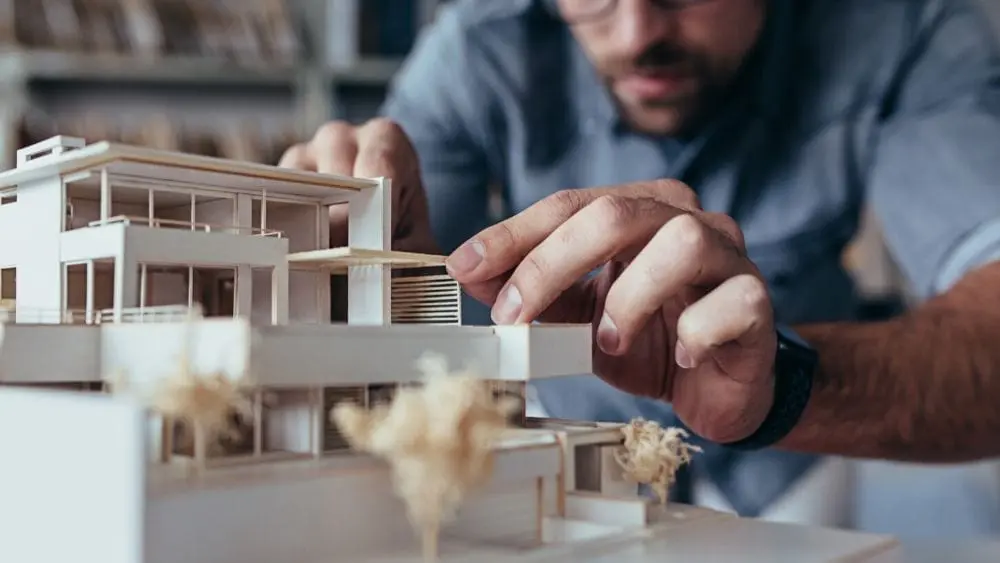
Buying a home is about making your dreams and visions come to life, and sometimes what’s for sale just isn’t a match. If that’s your predicament, you might want to consider bringing an architect on board to bring your homeownership dreams to life.
However, hiring an architect might seem a daunting proposition, especially if you’re not even certain what you perfect home would look like or cost. “People have the fear that the architect might overwhelm them and push them into something they’re not comfortable with. There is still the anxiety around whether or not this person can give them what they want, or is this person going to be Frank Lloyd Wright and give them what he wants based on what he [or she] thinks they want,” says Wayne Visbeen, principal of Visbeen Architects in Grand Rapids, Mich.
In reality, quite the opposite is true. Architects are skilled at helping clients discover and realize their individual vision while also taking into consideration site requirements, zoning restrictions, budgets, and functionality. “Architects see the big picture when it comes to your project. They help you explore what appeals to you aesthetically and what you require functionally. They coordinate teams of design, engineering and construction professionals; they sort through the maze of building codes and zoning requirements,” explained South Carolina architect Charles Hultstrand, speaking behalf of the American Institute of Architects.
Research All Your Options
A careful search for prospects, interviews with three or more candidates and knowledge of services typically offered will help allay most initial concerns. Not understanding the breadth of services that can be contracted is not uncommon, says Elissa Morgante, a principal of Morgante Wilson Architects in Chicago.
Residential architects work with clients in several different ways from just designing a basic enclosure or slightly more defined interior layouts to including all the built-in components in a plan and helping clients determine what materials would work best within budget. Beyond that, services often extend to working with clients to select a builder, assessing competitive bids, and supervising construction as it progresses to ensure the home is built to specifications and the work is done properly. A number of architectural firms will also offer interior design services.
Interview Potential Candidates
Look for an architect early on in the process, especially if you are searching for a lot or land. A professional can evaluate a site and help explore options you may not have considered.
Online platforms such as Houzz make the task of finding an architect and getting a sense of their work much easier. Connect with friends or family members who have worked with architects as well as the local chapter of the American Institute of Architects.
Experts typically recommend interviewing several candidates for the job. Often, Morgante says, consumers will only interview two architects. If they both happen to work in the same way, they assume all architects work that way. That’s not always the case
Know who you are dealing with, advises Visbeen. “Many people come to us saying they interviewed three architects in town, and I find out I am the only architect among the three.” In addition to an undergraduate degree in architecture, many licensed architects also have advanced degrees. They will have completed an internship and passed a rigorous licensing exam. AIA also offers an associate level of membership for individuals without a license but who meet the organization’s education or employment requirements.
Personal Style Should be Considered
How much do you need to know about the type of house you want? Surprisingly, not as much as you might expect. “Some people just say they want a cool house,” says Morgante. She recommends having an idea of the number of bedrooms and baths, and a general sense of what you might want in a new home. “A majority of architects will work with you to fine tune wants and needs and expectations in terms of style,” she says. They also can suggest ways to reduce costs and use spaces in multiple ways.
Still, Marianne Cusato, a developer, designer, and associate professor at the University of Notre Dame’s school of architecture, cautions, “If you want a traditional home, don’t go to someone who only designs glass boxes, and vice versa. Some firms have a distinct style; if you like their style, then this is a good fit. If not, it will be a struggle.”
Also confusing, say experts, is the term “custom home.” This phrase is often used to characterize new builds that give consumers options to adapt floorplans and finishes, but the plan itself isn’t designed for a specific client.
Find an Architect You Trust
An architect doesn’t necessarily have to be local. What is most important is finding the person with the right caliber of skills and with whom you can have open communication. “If you don’t connect with them or trust them, move on to the next option. Designing and building a home is stressful, time consuming, and expensive. The relationship with your professional team must be solid or the stress will be compounded,” says Cusato.
It’s not unusual to have more than one meeting with a candidate before you decide to commit. Initial meetings will give you a sense of how they work, members of their team, their experience, how well they listen, and whether there is any chemistry.
Consider All the Costs
Cost is another variable. Architecture firms bill in different ways: by the hour, a percentage of the cost of work or the size of the house. Most common, according to AIA, is time-based compensation or a stipulated fee that is agreed upon at the beginning of the design phase.
If you think having an architect on board will push the cost of your new home home beyond your budget, you might be surprised to learn architects can actually save money for clients. Good plans revolve around functionality and often cost less in the end because they make the best use of space and require less square footage be purchased. One common pitfall is buying a standard plan that is too large. That extra 500-square feet built at $200 a foot translates in to $100,000, says Visbeen. “A well-designed home will live better, function better, and save you money over a poorly designed home,” says Visbeen. “Get the design right, and everything else will fall into place.”

Camilla McLaughlin is an award-winning writer specializing in house and home. Her work has appeared in leading online and print publications, such as Yahoo! Real Estate, Unique Homes magazine and Realtor magazine. She has also freelanced for the Associated Press.
 Is a Landscape Design Plan For You?
Is a Landscape Design Plan For You?